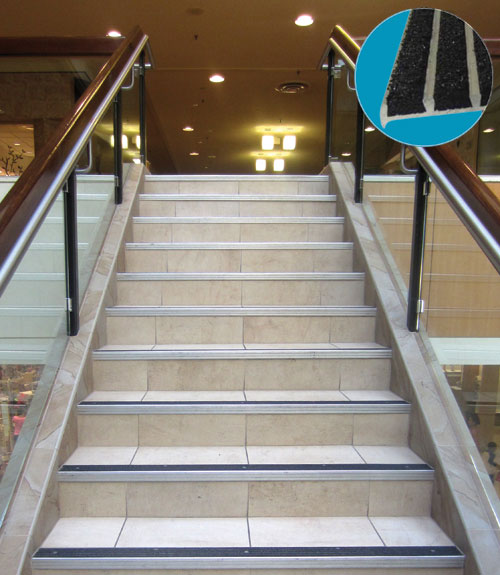Stair Treads and Nosings
Building codes commonly define a stair as “a change in elevation, consisting of one or more risers” with a riser being the vertical portion of the individual steps. They go on to define a stairway as “one or more flights of stairs” and also include “the necessary landings and platforms connecting them, to form a continuous and uninterrupted passage from one level to another.” Hence a stairway is the total assembly connecting levels within a building. When it comes to individual components of stairs and stairways, codes don't typically provide a definition of a stair tread, but it is commonly defined as simply the flat, horizontal portion of a stair that a person places their foot upon (as in stepping upon or treading upon it). Codes typically require a minimum depth of stair treads on the order of 11 inches and mandate consistency in their dimensions along a run or flight of stairs. Stair nosings are a distinct part of a tread that building codes define as “the leading edge of stair treads.” Nosings also apply to the leading edge of landings at the top of stairway flights. The codes address the size and depth of the nosing for different stair profiles and call for them to provide a degree of slip resistance along their surface. For purposes of this article, all of these elements of defining stairs, stairways, and treads and nosings apply. However, we will generally differentiate a tread from a nosing based on the stair industry standard—a nosing is defined as 4 inches or less in depth and a tread is defined as greater than 4 inches in depth (i.e. commonly the full depth of the stair tread).
In light of all of the above, it is common current practice to design and specify stair treads and nosings as distinct elements of the overall stair design. As distinct elements, they can be added to the supporting material of wood, concrete, or steel that the stairs are made from. Further, they can be specified for both new and retrofit/renovation installations. For commercial and institutional buildings with moderate to high levels of foot traffic, extruded aluminum nosings and treads are often selected for both interior and exterior locations. The aluminum extrusions are typically filled with abrasive material running from side to side along the width of the tread or nosing. When using this approach in stair treads, the abrasive material is typically installed in channels in the extrusion, thus forming alternating strips of exposed aluminum and abrasive running across the stair tread. It is also possible to use “full abrasive” treads and nosings which have the abrasive material covering over the top of the extrusions so that only the abrasive material is seen.
In industrial or very heavy foot traffic conditions, full cast aluminum treads and nosings can be used. This approach is also applicable for both new construction and renovation/retrofit applications. These are solid aluminum products on the order of 5/16-inch thickness that are manufactured through a sand casting process instead of an extrusion process. Their profiles are often made specifically to fit onto either new or existing poured concrete or concrete filled steel pan stairs. In cases where only the nosing is desired to be added, they are available in different widths and styles. Where full cast aluminum treads are desired, the nosing is typically integral to the product along the leading edge. In either case, they are finished with an abrasive silicon carbide covering over the top of the cast aluminum. They may also include a diamond or crosshatch safety pattern in the aluminum for greater slip resistance. The cast aluminum will take the brunt of the traffic and any abuse, thus protecting and preserving the concrete beneath it and helping to ensure a well-maintained stair that remains intact and safe over time.
 |
Stair treads are the full horizontal surface that a person steps upon while the nosing is the leading edge of the tread. Photo courtesy of Nystrom, Inc. |









